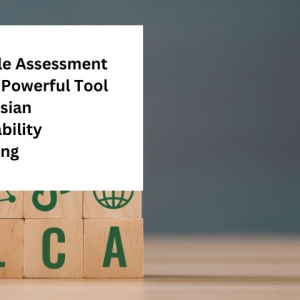As climate action becomes a global imperative, businesses in Malaysia are increasingly focusing on sustainability. A critical part of this is understanding and managing your environmental impact. Greenhouse gas (GHG) accounting is the foundation for any meaningful climate strategy. It provides the data needed to reduce your carbon footprint, comply with regulations, and meet stakeholder expectations.
This guide will walk you through the process of implementing GHG accounting within your Malaysian organization. You will learn how to measure your greenhouse gas emissions, set meaningful targets, and report your progress. By following these steps, you can build a credible and robust system for managing your company's climate impact.
Understanding GHG Accounting and Its Importance in Malaysia
GHG accounting is the process of quantifying the greenhouse gas emissions produced directly and indirectly by an organization's activities. Think of it as financial accounting, but for emissions instead of money. The primary framework used worldwide is the GHG Protocol, which categorizes emissions into three "scopes."
- Scope 1: Direct emissions from sources owned or controlled by the company. This includes fuel combustion in company vehicles and furnaces.
- Scope 2: Indirect emissions from the generation of purchased electricity, steam, heating, or cooling consumed by the company.
- Scope 3: All other indirect emissions that occur in a company’s value chain. This is often the largest and most complex category, covering everything from purchased goods and services to business travel and employee commuting.
For Malaysian businesses, embracing GHG accounting is no longer optional. With the government’s commitment to becoming a carbon-neutral nation by 2050, regulatory pressures are mounting. Bursa Malaysia has already made sustainability reporting, including GHG emissions data, mandatory for Main Market and ACE Market listed companies. Beyond compliance, transparent GHG accounting builds trust with investors, attracts environmentally conscious customers, and can uncover cost savings through improved energy efficiency.
Step 1: Secure Commitment and Define Your Goals
Before you can count a single gram of CO2, you need buy-in from the top. Implementing a GHG accounting system requires resources, time, and cooperation across departments.
Gain Leadership Support
Present a clear business case to your senior management. Highlight the risks of inaction, such as regulatory penalties and reputational damage. Emphasize the opportunities, including enhanced brand value, competitive advantage, and operational efficiencies. A strong mandate from leadership ensures the project receives the necessary support to succeed.
Form a Cross-Functional Team
GHG accounting is not just a job for the sustainability department. You will need data from various parts of your organization. Form a team with representatives from:
- Operations: To provide data on energy consumption, fuel use, and industrial processes.
- Finance/Procurement: For information on purchased goods, services, and utility bills.
- Human Resources: To gather data on employee commuting and business travel.
- Facilities Management: For details on buildings, vehicles, and waste management.
Designating a clear project lead will help coordinate efforts and keep the process on track.
Set Clear Objectives
What do you want to achieve with GHG accounting? Your goals will shape the scope and focus of your efforts. Common objectives include:
- Establishing a baseline carbon footprint.
- Complying with Bursa Malaysia's sustainability reporting requirements.
- Identifying emission reduction opportunities.
- Setting science-based reduction targets.
- Responding to investor and customer inquiries.
Defining your goals upfront will help you prioritize your efforts and measure success.
Step 2: Define Your Organizational and Operational Boundaries
Next, you need to decide what to include in your emissions inventory. This involves setting clear boundaries for your organization and its operations.
Setting Organizational Boundaries
This defines which entities, subsidiaries, and facilities are included in your inventory. The GHG Protocol provides two main approaches:
- Equity Share: You account for GHG emissions from operations according to your share of equity in the operation. If you own 50% of a joint venture, you account for 50% of its emissions.
- Control Approach: You account for 100% of the GHG emissions from operations over which you have financial or operational control. This is the most common approach used by businesses.
Choose the approach that best reflects your business structure and apply it consistently.
Defining Operational Boundaries
This involves identifying the emissions associated with your operations and categorizing them into Scopes 1, 2, and 3.
- Start with Scopes 1 and 2: These are the most direct and generally easier to calculate. They cover your direct fuel consumption and purchased electricity. This is the minimum requirement for many reporting standards.
- Screen Scope 3 Categories: Scope 3 includes 15 distinct categories. It can be overwhelming to tackle them all at once. Start by identifying which categories are most relevant to your business. For a manufacturing company, "purchased goods and services" will likely be a major source. For a consulting firm, "business travel" might be more significant.
Your goal is to create a comprehensive inventory that accurately reflects your company's carbon footprint.
Step 3: Collect Data and Calculate Emissions
This is the core of the GHG accounting process. The accuracy of your inventory depends on the quality of your data.
Identify Data Sources
Work with your cross-functional team to locate the necessary data. Common data sources include:
- Scope 1: Fuel purchase records, vehicle mileage logs, onsite generator fuel consumption data.
- Scope 2: Electricity bills from utility providers like Tenaga Nasional Berhad (TNB).
- Scope 3: Supplier spending data, travel expense reports, employee surveys for commuting data, waste disposal records.
Gather Activity Data
Activity data is the measurement of a business activity that results in emissions. Examples include:
- Litres of diesel consumed by company trucks.
- Kilowatt-hours (kWh) of electricity purchased.
- Kilometres traveled by employees for business trips.
- Tonnes of waste sent to landfill.
Aim to collect primary data directly from your operations wherever possible. When primary data is not available, you can use industry averages or financial data to make reasonable estimates.
Apply Emission Factors
Once you have your activity data, you need to convert it into GHG emissions. This is done using emission factors. An emission factor is a value that quantifies the emissions released per unit of activity (e.g., kg CO2e per litre of petrol).
The basic calculation is:
Emissions = Activity Data x Emission Factor
Key sources for emission factors relevant to Malaysia include:
- Peninsular Malaysia Grid Emission Factor: Published by the Malaysian Green Technology and Climate Change Corporation (MGTC), this factor is essential for calculating Scope 2 emissions from electricity purchased from the TNB grid.
- International Databases: The UK's Department for Environment, Food & Rural Affairs (DEFRA) and the Intergovernmental Panel on Climate Change (IPCC) provide comprehensive databases of emission factors for a wide range of activities.
Using software or spreadsheets can help manage these calculations, especially as your inventory grows in complexity.
Step 4: Verify Your Data and Prepare a GHG Report
A robust inventory is one that can withstand scrutiny. Verification adds credibility to your results.
Internal Review and Verification
Have someone on your team who was not involved in the data collection process review the inventory. They should check for errors in calculations, data entry, and application of emission factors. This internal check helps ensure the accuracy and completeness of your GHG inventory.
External Assurance (Optional but Recommended)
For greater credibility, consider hiring an independent third party to verify your GHG inventory. An external audit provides assurance to stakeholders that your data is accurate, complete, and compliant with established standards. This is becoming a standard practice for large public companies.
Create a GHG Inventory Report
Your report should transparently document your process and findings. A good report includes:
- A description of the company and the period covered.
- The organizational and operational boundaries chosen.
- Total emissions data for Scopes 1, 2, and any included Scope 3 categories, reported in tonnes of carbon dioxide equivalent (tCO2e).
- An explanation of the methodologies and emission factors used.
- Information on any data uncertainties or exclusions.
This report serves as a key document for internal decision-making and external sustainability reporting.
Step 5: Set Targets and Take Climate Action
GHG accounting is not just a reporting exercise; it's a tool for driving change. The data you've gathered is the foundation for your climate action strategy.
Set Meaningful Reduction Targets
Use your baseline inventory to set informed and ambitious emission reduction targets. Targets can be:
- Absolute: A commitment to reduce total emissions by a specific amount (e.g., reduce absolute Scope 1 and 2 emissions by 30% by 2030).
- Intensity-based: A commitment to reduce emissions relative to a business metric (e.g., reduce emissions per unit of production by 50% by 2030).
Aligning your targets with climate science, such as through the Science Based Targets initiative (SBTi), demonstrates a serious commitment to climate action.
Develop a Reduction Plan
Identify the largest sources of emissions in your inventory—these are your "hotspots." Brainstorm and evaluate potential initiatives to address these hotspots. Examples include:
- Energy Efficiency: Upgrading to energy-efficient lighting and equipment.
- Renewable Energy: Installing solar panels on your facilities or participating in Malaysia's Green Electricity Tariff (GET) program.
- Fleet Management: Transitioning to electric vehicles (EVs) or optimizing delivery routes.
- Supply Chain Engagement: Working with suppliers to help them reduce their own emissions.
Prioritize initiatives based on their potential impact, cost, and feasibility. Create a clear action plan with timelines, responsibilities, and key performance indicators (KPIs).
Conclusion
Implementing GHG accounting is a journey that positions your organization for long-term success in a low-carbon economy. By systematically measuring your carbon footprint, you gain the essential insights needed to manage risks, unlock efficiencies, and demonstrate climate leadership. This step-by-step process provides a clear roadmap for any Malaysian business ready to take control of its environmental impact.
The journey doesn't end with your first GHG report. It is an iterative cycle of measuring, reporting, and acting. Regularly update your inventory, track your progress against targets, and continuously seek new opportunities for reduction. By embedding GHG accounting into your business strategy, you are not only preparing for regulatory demands but also building a more resilient, competitive, and sustainable organization for the future.







